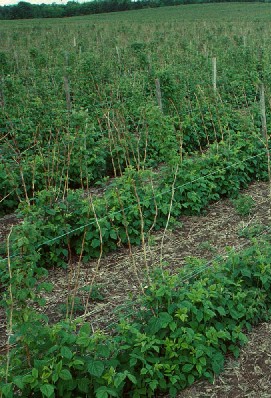
Raspberry cane midge (Resseliella theobaldi) larvae feed on raspberry canes and are associated with the disease complex known as 'midge blight' in much of Europe. Larvae overwinter in the soil in cocoons and emerge in the spring. Eggs are laid in splits and wounds in the bark at the base of the primocanes. The larvae feed on cortical tissue protected by the covering of bark. Fully fed larvae drop to the soil and pupate. A further two to four generations follow throughout the summer and early autumn. If the first generation midges find adequate feeding sites and develop successfully, the second and subsequent generations can be very large. A range of fungi infects these feeding sites resulting in cane death during the following winter.

The current control strategy in the UK and in other European countries is to apply high volume sprays of insecticides when the midge begins to lay eggs in the spring. However, with the current re-evaluation of pesticides in the UK and elsewhere, organophosphorus-based insecticides are likely to be withdrawn in the near future and suitable alternatives must be sought with a degree of urgency. Although fungi are involved in this disease complex, fungicides have never successfully controlled midge blight. A predictive model, which uses the relationships between the date of emergence of over-wintered raspberry cane midge and meteorological data has been described. Some raspberries and hybrid berries Tayberry and Loganberry do not split their rind in the spring and are rarely affected by 'midge blight'.
